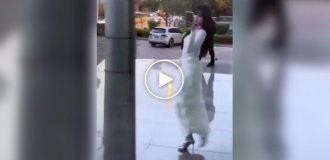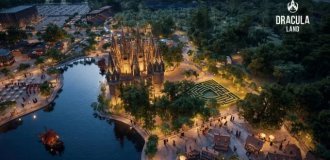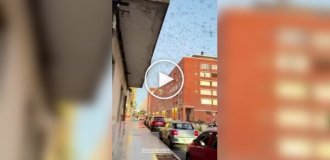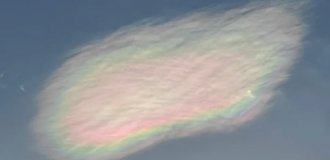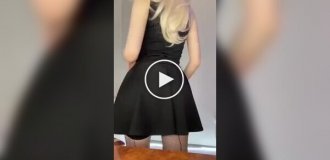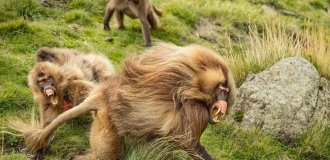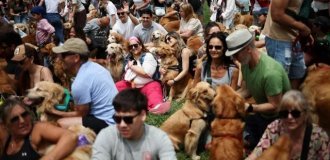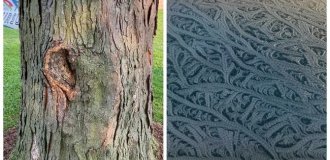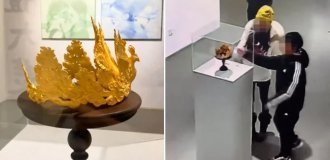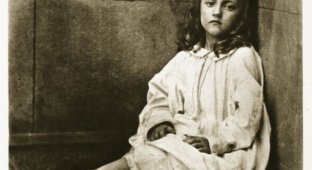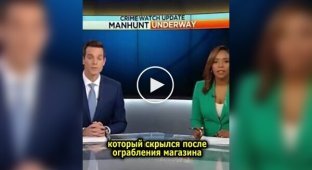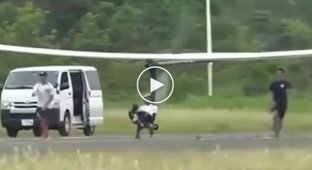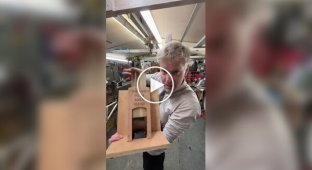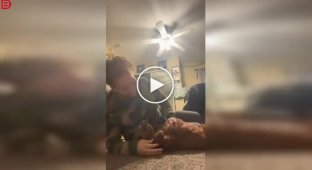Falsification of photographs in the Stalin era (11 photos)
Many probably still remember the recent scandal with photographs of the Lebanese-Israeli conflict, which Reuters posted on its website and admitted that one of its photographers, Adnan Haj, used computer programs to distort reality. And recently I came across an interesting album that talks about the falsification of photographs and works of art in the Stalin era. "...The author, David King, reproduces, whenever possible, the original photograph and its retouched version, and sometimes several. Let's say, people disappear from a photograph one by one, as they disappear from life or from the political arena. In one print, in 1920, Lenin and Krupskaya went to open a power plant in Kashin and took a photograph with a group of kulaks (in the background) and children (in the foreground). After 19 years, ALL the adults and some of the children were erased from the photo. It’s clear why. You look and you think: this one is laughing, but he is no longer there. This one looks in fear - and he is gone... And then - a collapse according to the book: these are not there, and these were destroyed, and those over there, and those..."

A few photos with comments from the album.

Walk along the banks of the Moscow-Volga canal. Yezhov, who before his arrest was removed from his second high post - People's Commissar of Water Transport - is no longer present in the retouched version next to Voroshilov, Molotov and Stalin. Many years later, Khrushchev said that Yezhov was not only an alcoholic, but also a drug addict and “got what he deserved.”

Top photo: party and government leaders with artists of the Moscow Art Theater on the day of celebrating the fortieth anniversary of the troupe, October 27, 1938.
Yezhov is in the second row, fifth from the right, next to Nikita Khrushchev.
Bottom photo: published in 1949, in connection with Stalin's seventieth birthday. The retoucher removed Yezhov and Boyarsky, the former director of the Art Theater, who by that time had also been shot.
On December 8, 1938, Yezhov was removed from his post as People's Commissar of Internal Affairs. He was succeeded by Beria, who on April 10, 1939 personally arrested Yezhov. And on February 4, 1940, Yezhov was shot.

Above: soldiers who demonstrated in the first days of the February Revolution of 1917, Petrograd, Liteiny Prospekt. In 1917, such postcards appeared in the thousands. In the background you can see the sign of the jewelry store "Watches. Gold and Silver." It is impossible to read what is written on the flag.
Below: a version of the same photograph that appeared in the same year, but on the sign of the jewelry store there is a different inscription. “In the struggle you will find your ancestry.” The black flag has turned white, and there is a clear inscription on it. "Down with the monarchy! Long live the republic!"

Lenin gives a speech in Petrograd, on Palace Square, July 19, 1920. The photo was taken by the famous photographer, Victor Bulla, on the opening day of the 2nd Congress of the Comintern. When they decided to publish the photo again - February 17, 1924. in the issue of the magazine "Krasnaya Niva" dedicated to the memory of Lenin, the editors apparently considered it necessary to emphasize Lenin's popularity more strongly. Despite the poor quality of the printing technique, it is striking that a much larger crowd is listening to Lenin than in the original photograph. The crowd was photographed on some other occasion.



In fact, Stalin deeply despised ordinary working people, as evidenced by at least two versions of this photograph taken in 1930, when the 16th Congress of the All-Union Communist Party of Bolsheviks was held. In the original photograph, one of the accompanying people helpfully shows the way to the “Boss” (as Stalin was often called). When the picture was published a little later in the magazine "Prozhektor", the worker was no longer there. There is no point in showing the leader the way. Children from Kashino

Lenin and his wife, Nadezhda Krupskaya, among wealthy men (kulaks) from Kashino at the opening of the power plant. The photo was taken by F. Feofanov on November 14, 1920. The bottom photograph was republished nineteen years later, at the height of the purges. By that time, the Bolsheviks had exterminated almost all the adult residents of the village of Kashino, although not sparing the children.
The dark background created by retouchers gives the photo an ominous tone.

Chapaev: Living Legend

Commanders and commissars of the 25th Ufa Rifle Division in the Urals. June 9, 1919 In the center is Vasily Ivanovich Chapaev (with a bandaged head), the legendary commander who died in the same year. To his left is Dmitry Andreevich Fkrmanov, a former anarchist, here is a political commissar and writer: a feature film was made based on his novel “Chapaev” in the 30s. In this form, the photograph was published in the magazine "Prozhektor" (March 1926), then, in 1932. in the photo album "Chapaev".

This version of the photograph was recently discovered in Soviet archives. Thanks to retouching and cropping, a group of forty-one people was reduced to thirty, but at the same time the faces of four of the eleven eliminated commanders were transferred to other people's torsos.
This significant reduction in the group is explained by Stalin’s “purge” of 1937, which did not spare the ranks of the Red Army: more than 25,000 commanders and commissars became victims.
The book is called "The Lost Commissioners". It became widely known and was translated into many languages of the world. The album's materials formed the basis of a traveling exhibition, which has been successfully traveling from country to country since 1998.
David King has been collecting documents, photographs and works of art related to the Soviet era for many years. He is the author, compiler and designer of many illustrated albums dedicated to this time, including a photobiography of Leon Trotsky.
From 1965 to 1975, David King was art director of the London illustrated magazine The Sunday Times. Currently he continues to work as an independent photographer and designer. Lives in London.

